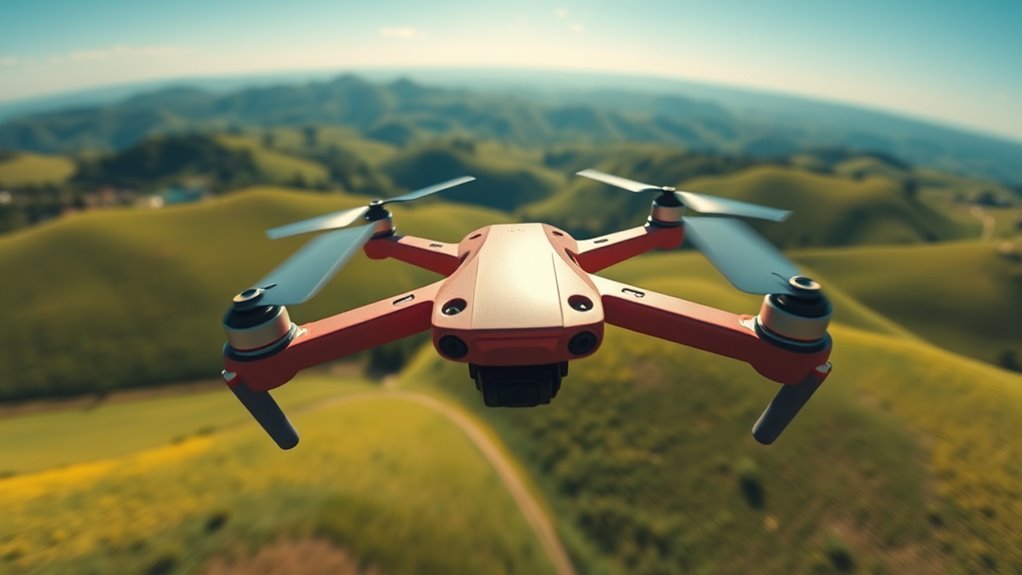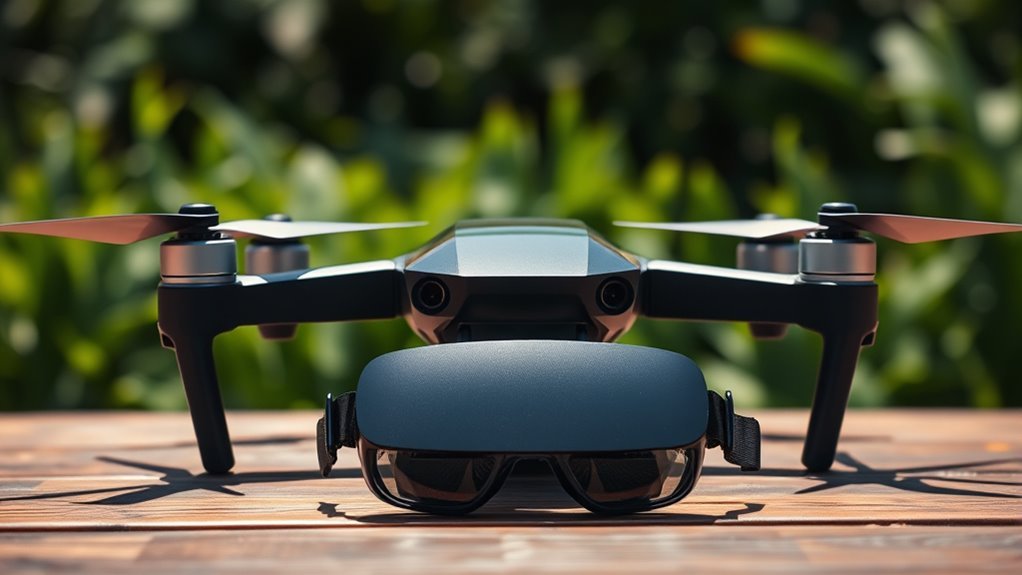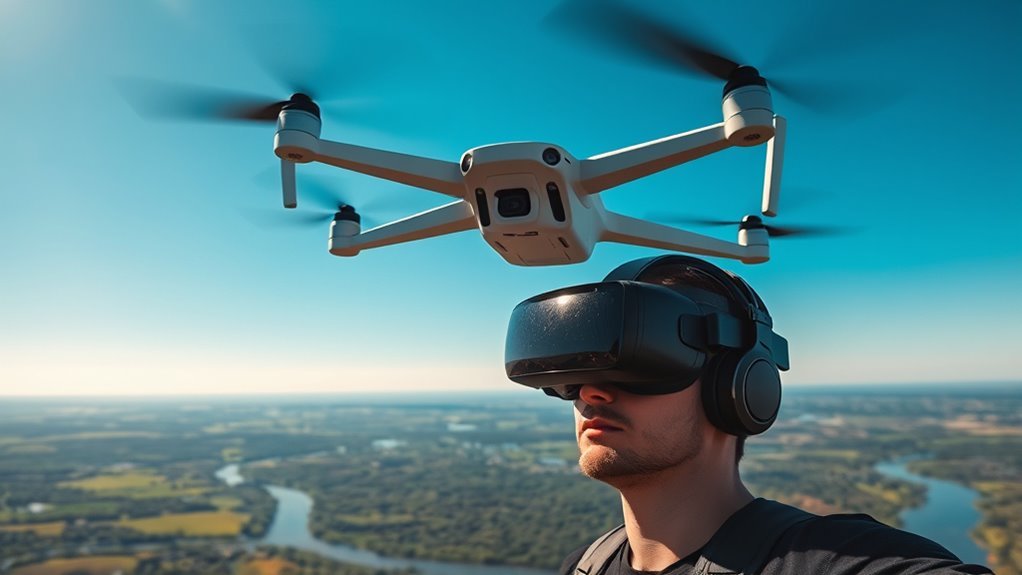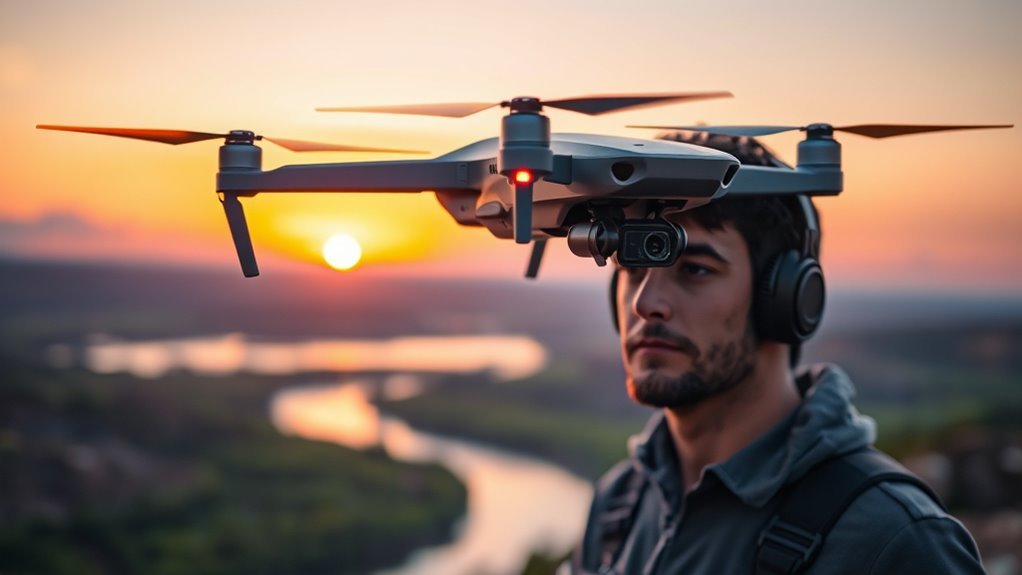FPV stands for First Person View, allowing you to pilot drones as if you’re sitting inside them. This immersive experience enhances your control and responsiveness, making it easier to maneuver with precision. FPV technology has evolved markedly, leading to better video transmission and image quality. Understanding these advancements is essential for maximizing your flying experience. There’s much more to explore about FPV drones, including their features and the types available.
What Is FPV (First Person View)?

FPV, or First Person View, refers to a method of piloting drones where the operator experiences flight from the drone’s perspective. This FPV technology creates an immersive experience, allowing you to feel as if you’re soaring through the skies. The user interface typically includes goggles or screens that display live video feeds, providing real-time feedback essential for guiding complex flight dynamics. With the right equipment setup, you can enhance your control and responsiveness, ensuring precision in maneuvering. Understanding the intricacies of FPV can empower you to explore new heights and release your creativity. As you engage with this technology, you’ll find that the freedom of flight becomes not just a desire, but an exhilarating reality.
The Evolution of FPV Technology

FPV technology has undergone significant transformations since its inception, driven by early drone innovations that laid the groundwork. You’ll notice how advancements in transmission methods have enhanced the reliability and clarity of video feeds, leading to a more immersive flight experience. Understanding these developments is vital for grasping the current capabilities and future potential of FPV drones. Additionally, innovations in autonomous deployment have further improved operational efficiency in various drone applications.
Early Drone Innovations
As the demand for immersive aerial experiences grew, pioneers in drone technology began experimenting with first-person view (FPV) systems, leading to significant innovations in the field. In the early drone history, these innovators faced challenges regarding video transmission and control responsiveness. They developed rudimentary FPV systems, combining lightweight cameras and analog signals, which allowed users to experience flight from a pilot’s perspective. This pioneering drone technology laid the foundation for future developments, enhancing user engagement and precision in navigation. As these early systems evolved, they spurred a community of enthusiasts and engineers to push the boundaries of what drones could achieve, ultimately fostering a culture of freedom in aerial exploration and creativity. The groundwork established during this period remains essential today.
Advancements in Transmission
While the initial FPV systems laid the groundwork, advancements in transmission technology have dramatically transformed the flying experience. Modern FPV systems now feature enhanced transmission ranges, allowing you to fly farther and explore previously unreachable areas. These improvements stem from the development of frequency-hopping spread spectrum technology, which minimizes signal interference and guarantees a stable connection even in challenging environments. The shift from analog to digital transmission has further refined image quality, providing you with clearer, more vibrant visuals during flights. As a result, you can enjoy greater freedom in your flying endeavors, pushing the boundaries of what’s possible. Understanding these advancements is vital for maximizing your FPV experience and steering the skies with confidence.
Immersive Flight Experiences
With the rapid evolution of FPV technology, enthusiasts are now able to experience flight in ways that were once unimaginable. Immersive experiences have transformed how you interact with your environment, bringing a sense of freedom that traditional flight methods can’t match. Advanced virtual reality (VR) integrations allow you to feel as if you’re actually in the cockpit, enhancing your spatial awareness and control. High-definition video feeds and low-latency transmission are essential, providing real-time feedback that immerses you deeper into the flight. This technological synergy not only elevates the thrill of flying but also expands your creative possibilities, enabling you to navigate complex environments and capture breathtaking footage. As FPV technology continues to evolve, the potential for new immersive experiences is limitless.
How FPV Drones Work

FPV drones operate through a sophisticated integration of components that work in harmony to deliver an immersive flying experience. At the core of FPV technology are essential FPV components, including cameras, transmitters, and receivers. The onboard camera captures real-time video, which is transmitted wirelessly to your goggles or monitor, allowing you to experience flight from the drone’s perspective. Meanwhile, the transmitter sends control signals from your remote to the drone, ensuring responsive maneuverability. The combination of these elements creates a seamless feedback loop, enabling you to navigate with precision and agility. This intricate system empowers you to explore the skies freely, enhancing your connection to the environment while maintaining control over every flight.
Key Features of FPV Drones
Five key features define the capabilities of FPV drones, considerably enhancing their performance and user experience. Understanding these FPV drone features can help you choose the right model for your needs. Here are three essential components to take into account:
- Camera Quality: High-resolution cameras provide clear, immersive video, vital for FPV flying.
- Transmission Range: Reliable video transmission systems guarantee you maintain control and visibility over longer distances.
- Battery Life: Extended battery life allows for longer flights, enabling you to explore more without interruptions.
Benefits of Using FPV Drones
Using FPV drones can transform your aerial experiences, offering a unique blend of immersion and control that traditional drones often lack. You’ll enjoy enhanced mobility, allowing you to maneuver through tight spaces and complex environments with ease. This agility opens new opportunities for capturing stunning aerial photography, as you can navigate around obstacles and approach subjects more closely. The first-person perspective gives you a pilot’s view, enhancing your ability to compose shots creatively. Additionally, FPV drones enable real-time feedback, letting you adjust your flight path instantly for best results. Whether you’re exploring landscapes or documenting events, the precision and freedom that FPV drones provide will elevate your creative endeavors to unprecedented heights. Furthermore, the superior control offered by advanced stabilization systems in some models allows for even more dynamic and stable flight experiences.
Comparing FPV Drones to Traditional Drones
While traditional drones often focus on stable, automated flight and user-friendly operation, FPV drones prioritize immersive control and agile maneuverability. Whether you’re into competitive racing or capturing stunning aerial photography, understanding the differences can enhance your experience. Here’s a quick comparison:
- Control: FPV drones offer real-time feedback and allow you to pilot with precision, while traditional drones generally rely on GPS stability.
- Speed: FPV drones are designed for rapid acceleration and sharp turns, making them ideal for racing, whereas traditional drones favor smooth, steady flight.
- Camera Options: Traditional drones typically come with high-quality cameras for aerial photography, while FPV systems often use lighter cameras to reduce drag and enhance speed.
Ultimately, each type serves distinct purposes, catering to different preferences and needs in drone flying.
Popular FPV Drone Models
When exploring popular FPV drone models, you’ll find that top racing drones prioritize speed and agility, making them ideal for competitions. Conversely, the best camera drones focus on stability and image quality, catering to those who want to capture stunning aerial footage. Understanding these distinctions will help you choose the right model for your specific needs.
Top Racing Drones
In the world of FPV racing drones, several models stand out for their performance and popularity among enthusiasts. If you’re looking to dominate racing competitions with high speed performance, consider these top contenders:
- DJI FPV Drone – Known for its exceptional stability and speed, this drone gives you an immersive flying experience.
- EMAX Hawk 5 – A lightweight frame with powerful motors, the Hawk 5 excels in agility and responsiveness during intense races.
- Fat Shark 101 – This model is favored for its customizable components, allowing you to fine-tune performance for specific racing conditions.
Each of these drones offers unique features that cater to serious racers, ensuring you’re equipped to push your limits and enjoy the thrill of competition.
Best Camera Drones
For enthusiasts looking to capture stunning visuals, camera drones have become increasingly popular in the FPV community. The best camera drones combine advanced technology with user-friendly features, making them ideal for drone photography.
| Model | Camera Resolution |
|---|---|
| DJI FPV | 4K @ 60fps |
| iFlight Nazgul 5 | 4K @ 30fps |
| Eachine Tyro 129 | 1080p @ 60fps |
| Holybro Kopis 2 | 4K @ 30fps |
These models excel in providing high-quality imagery while maintaining the agility needed for FPV flying. Whether you’re a novice or a seasoned pilot, investing in one of these drones will elevate your aerial photography experience, allowing you to explore new creative horizons.
Regulations and Safety Considerations for FPV Flying
Though FPV (First-Person View) flying offers an exhilarating experience, it is crucial to navigate the complex web of regulations and safety considerations that govern this activity. Ignoring these can lead to serious consequences. Here are three key points to guarantee compliance with fpv regulations and maintain safety:
- Know Your Airspace: Always check local airspace restrictions. Certain zones, like near airports, may have strict regulations.
- Maintain Line of Sight: While FPV flying allows immersive experiences, you must keep your drone within visual range unless using a spotter.
- Follow Safety Guidelines: Adhere to guidelines set by aviation authorities, including weight limits and registration requirements. Additionally, understanding real-time data utilization can enhance your flying safety by providing insights into environmental conditions.
Tips for Getting Started With FPV Drones
Getting started with FPV drones can be both exciting and intimidating, especially when you’re enthusiastic to plunge into the technological aspects. To ease your entry, focus on a few beginner tips. First, invest in essential gear: a reliable drone, quality FPV goggles, and a solid transmitter. Choose a drone with user-friendly features, like GPS and altitude hold, to help you gain confidence.
Next, practice in open areas to familiarize yourself with controls and flight dynamics. Don’t rush into advanced maneuvers; build your skills gradually. Consider joining local FPV communities for insights and support. Finally, always check local regulations before flying to verify compliance, enhancing your freedom to explore the skies safely.
Frequently Asked Questions
Can FPV Drones Be Used for Racing Competitions?
Yes, FPV drones can be used for racing competitions, provided they adhere to specific racing regulations. These events demand precision and skill, allowing you to experience the thrill of competitive flying while showcasing your expertise.
What Is the Average Cost of an FPV Drone?
When considering FPV drone pricing, the average cost can range from $200 to over $1,500. Conducting a thorough cost comparison helps you choose the best option for your specific needs and desired features.
Are FPV Drones Suitable for Beginners?
Like learning to ride a bike, FPV drones can be suitable for beginners with proper training. Start with beginner tips and focus on FPV training to gain confidence, ensuring a smoother flight experience as you explore.
How Long Do FPV Drone Batteries Typically Last?
FPV drone battery lifespans usually range from 5 to 20 minutes, depending on capacity and flying style. Using ideal charging methods can enhance longevity, ensuring you maximize your time in the sky and enjoy greater freedom.
What Accessories Are Essential for FPV Flying?
You’d think flying FPV requires just a drone, right? Yet, essential accessories like FPV goggles, flight controllers, and batteries are vital for an exhilarating experience. Don’t underestimate their importance in achieving true freedom in the skies!

